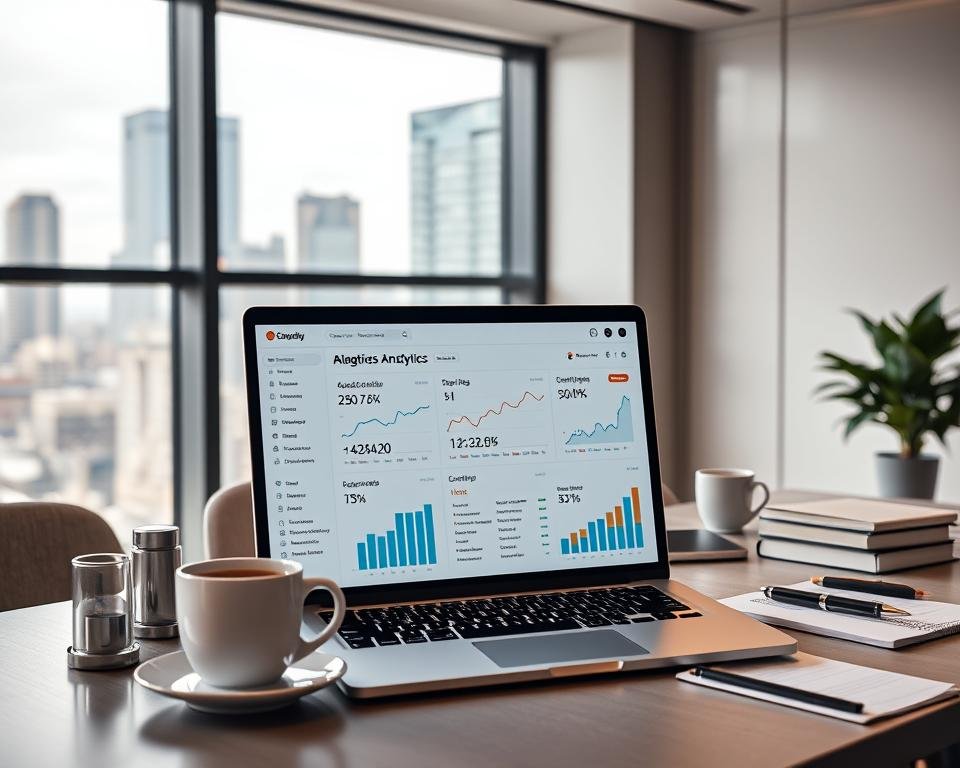Exploring online blogging shows that optimizing your blog for search engines is key. It helps increase your online presence and brings more visitors to your site.
With the right methods, you can greatly increase your earnings. In this article, I’ll share tips on how to optimize your blog. We’ll focus on important strategies to help you succeed in the competitive online world.
Key Takeaways
- Understanding the importance of SEO in online blogging
- Learning effective SEO strategies to increase online presence
- Discovering ways to drive more traffic to your blog
- Implementing techniques to boost earnings through online blogging
- Optimizing your blog for maximum visibility and engagement
Understanding SEO Basics for Blogs
As a blogger, knowing SEO basics is key to growing your online presence. SEO, or Search Engine Optimization, helps your site show up better in search results. This makes more people visit your site.
What is SEO and Why is it Important?
SEO is vital for bloggers who want to make money online. By making your blog search engine friendly, you can get more visitors. This can lead to more money from ads, affiliate marketing, and sponsored posts.
Key benefits of SEO for bloggers include:
- Increased online visibility
- Targeted traffic to the blog
- Improved brand credibility
- Enhanced user experience
- Potential for higher earnings
Key Components of SEO
SEO has many parts. Knowing these is important for a good SEO plan.
| Component | Description | Importance |
|---|---|---|
| Keyword Research | Identifying relevant keywords and phrases | High |
| On-Page Optimization | Optimizing elements on the webpage | High |
| Link Building | Acquiring high-quality backlinks | Medium |
| Technical SEO | Improving site speed, mobile-friendliness, and more | High |
Common SEO Myths Debunked
There are many SEO myths that can confuse bloggers. Let’s clear up some of these myths.
- Myth 1: SEO is a one-time task. Reality: SEO is an ongoing process that requires continuous effort.
- Myth 2: Keyword stuffing improves rankings. Reality: Keyword stuffing can lead to penalties from search engines.
- Myth 3: SEO is only about search engines. Reality: SEO is also about improving the user experience.
Keyword Research Strategies for Monetization
Keyword research is key in SEO. It helps bloggers find and use popular keywords. This way, they can make content that people want, boosting their site’s visibility and earnings.

Identifying High-Traffic Keywords
Finding keywords with lots of searches is the first step. Tools like Google Keyword Planner and Ahrefs help find these keywords. It’s important to look at what others are doing and why people search for certain things.
High-traffic keywords get a lot of searches but are very competitive. Bloggers should also look at less competitive keywords with good search numbers.
Tools for Effective Keyword Research
Many tools can help with keyword research, each with its own strengths:
- Google Keyword Planner: Great for finding keywords and seeing how well they might do.
- Ahrefs: Gives detailed keyword analysis, including what competitors are doing.
- SEMrush: Offers SEO audits and insights on keyword strategies.
- Moz Keyword Explorer: Helps find and order keywords by how well they fit and how hard they are to rank.
With these tools, bloggers can create a strong keyword plan that fits their content and audience.
Long-Tail Keywords vs. Short-Tail Keywords
Knowing the difference between long-tail and short-tail keywords is important. Short-tail keywords are short and general (like “SEO tips”). Long-tail keywords are more specific (like “SEO tips for bloggers”).
Long-tail keywords might not get as many searches, but they’re less competitive. They’re also more likely to match what users are looking for, leading to more conversions.
Bloggers should use a mix of short-tail and long-tail keywords. This strategy attracts more people and helps with SEO.
On-Page SEO Techniques for Blogs
On-page SEO is key for bloggers to boost their site’s performance and make more money online. By tweaking different parts of their blog, they can climb the search engine ranks. This brings in more visitors and boosts their earnings.
Crafting SEO-Friendly Titles and Meta Descriptions
Writing titles and meta descriptions that grab attention is vital. A good title should be short, clear, and include the main keyword. For example, using “SEO techniques for monetizing blogs” in the title can help your post show up more in search results.
Best practices for titles and meta descriptions include:
- Keep titles under 60 characters so they show fully in search results
- Put the main keyword at the start of the title
- Make meta descriptions catchy and under 160 characters
- Use words that make people want to click
Optimizing Content for Readability and SEO
It’s important to make your content easy to read and SEO-friendly. Use simple language, break up text into short paragraphs, and add keywords naturally.

To make your content better, focus on creating valuable and engaging content. Use subheadings, bullet points, and short paragraphs to make it easy to read.
The Importance of Internal Linking
Internal linking is a must for SEO. It helps search engines see your blog’s structure and content order. By linking to other pages, you improve user experience, boost engagement, and help your SEO.
Effective internal linking strategies include:
- Link to content that’s relevant and adds value
- Use descriptive anchor text with target keywords
- Avoid too many links, which can lessen key page importance
Off-Page SEO Strategies to Boost Traffic
Off-page SEO is key for bloggers wanting more visitors. It helps your site get seen more. This is important for bloggers trying to make money online.
Building Backlinks the Right Way
Getting good backlinks is vital. It means getting links from other sites to yours. This tells search engines your content is great.
To get backlinks, make high-quality, linkable content. This is content others will want to share.
- Create guides or resources that help your audience.
- Write guest posts for sites in your niche.
- Join online communities related to your blog.
Here’s a simple table to show backlink types and their quality:
| Backlink Type | Quality | Description |
|---|---|---|
| Editorial Backlink | High | A link from a reputable site that references your content. |
| Guest Post Backlink | Medium | A link obtained through writing a guest post for another site. |
| Directory Backlink | Low | A link from a directory listing, which can be useful but less impactful. |
Leveraging Social Media for SEO
Social media is a big chance to share your content. It can bring more visitors to your site. It also helps your SEO by getting your content seen more.

Guest Posting and Its Benefits
Guest posting means writing for other blogs. It helps you get backlinks and reach more people. It also shows you’re an expert in your field.
- Find sites that let you guest post.
- Write content that’s valuable to the host site.
- Put a link to your blog in your author bio or content.
Using these off-page SEO strategies can really help your blog. It can bring more visitors, make you more visible online, and help you earn money through blogging.
Technical SEO Must-Knows for Bloggers
To make your blog better, you need to know about technical SEO. It helps your site show up better in search results. It also makes your site easier for people to use.
Understanding Site Speed and Mobile Optimization
Site speed and mobile optimization are key in technical SEO. A slow site can make people leave quickly. Also, most people now use mobiles to surf the web.
Improving site speed can be done in many ways. You can make images smaller, use browser caching, and cut down on CSS and JavaScript. Making your site work well on mobiles means it looks good on all devices.

Importance of Secure Sockets Layer (SSL)
Secure Sockets Layer (SSL) is key for keeping your site safe. It makes sure data between your site and users is safe. This keeps browsing safe for everyone.
SSL is also good for SEO. Sites with SSL get ranked higher by Google. Getting an SSL certificate is easy. You just buy and install it on your server.
XML Sitemaps and Their Role
XML sitemaps help search engines understand your site. They list all your site’s URLs. This makes it easier for search engines to find and index your pages.
By making and submitting an XML sitemap, you help search engines find all your site’s pages. This means your site can show up faster in search results.
Content Creation Tips for SEO Success
Creating high-quality content is key for bloggers wanting to make money online. Your content must be good for both your readers and search engines.
Writing Engaging and Valuable Content
To write great content, know your audience first. Find out what they need and what problems they face. Your content should be well-researched and offer solutions or insights they value.
Write in a friendly tone to connect with your readers. Use headings and subheadings to make your content easy to read.
Key elements of engaging content include:
- Relevance to your audience’s needs
- Clear and concise language
- Use of examples or anecdotes
- Proper use of headings and subheadings
Importance of Regular Updates and Freshness
Search engines like sites that update often with quality content. You don’t need to post every day. But, a regular schedule helps your site show up more in searches.
Updating your site regularly tells search engines it’s active. This can lead to better indexing and higher rankings.
| Update Frequency | Impact on SEO |
|---|---|
| Daily | Highly active sites, frequent crawling |
| Weekly | Regular updates, good for maintaining visibility |
| Monthly | Less frequent, but it’s okay for SEO |
Utilizing Different Content Formats
Use various content formats to reach more people. This includes videos, infographics, podcasts, and blog posts.
Mixing content formats can attract more visitors and boost your SEO. For example, adding videos or infographics can make your blog posts more engaging and keep readers longer.

- Videos: Engaging, can increase dwell time
- Infographics: Visual, easy to consume information
- Podcasts: Convenient for auditory learners
- Blog Posts: Detailed, informative, and versatile
User Experience and SEO Performance
User experience is key in SEO. A site that’s easy to use and full of info ranks better. This means it shows up higher in search results.

How Site Design Affects SEO
Website design matters a lot for SEO. A good design keeps users engaged and lowers bounce rates. Search engines look at these factors when ranking sites.
Fast loading is also important. A quick site gives users a better experience. Google likes sites that load fast because they’re better for users.
The Role of Navigation and Structure
Navigation and structure are key for users and search engines. A clear site helps users find what they need. It also makes it easier for search engines to index the site.
- A logical structure makes content easy to find.
- Clear menus help users stay on track.
- An organized site helps users and search engines find new content.
Tips for Reducing Bounce Rate
Lowering bounce rate helps with both user experience and SEO. Here are some tips:
- Make your site load faster to keep users interested.
- Make sure your site works well on mobile devices.
- Create content that users want to read.
- Use clear headings so users can quickly get the gist of your content.
By using these tips, bloggers can make their sites better for users and SEO. This can help them earn more online through good SEO practices.
The Power of Analytics in SEO
Analytics is key in SEO. It helps bloggers make smart choices based on data. They can see how their blog is doing, find what needs work, and change their SEO plans.
Using Google Analytics for Blog Insights
Google Analytics is a top tool for bloggers. It shows them how many people visit their site, how long they stay, and more. By using Google Analytics, bloggers can see how their content is doing and find ways to make it better.

Tracking Keywords and Performance
It’s important for bloggers to keep an eye on their keywords and how well their SEO is working. They can see which keywords bring in visitors and change their content to match. They also track how well people click on their site and how many do something important.
Key performance indicators (KPIs) to track include:
- Keyword rankings
- Organic traffic
- Click-through rates
- Conversion rates
Adjusting Strategies Based on Data
Analytics data should guide a blogger’s SEO plans. By looking at how their content does, they can spot trends and areas to improve. This helps them make smart choices about their SEO, like making more of what works and fixing what doesn’t.
For example, if some content is doing great, they can make more like it. If other content isn’t doing well, they can change it to better meet their audience’s needs.
Monetization Strategies Coupled with SEO Efforts
To make money blogging, you need to mix SEO with good ways to make money. This combo boosts your blog’s visibility and earnings.
Affiliate Marketing and SEO Synergy
Affiliate marketing is great for making money from your blog. Adding SEO to it makes it even better. You can get more visitors by using the right keywords.
I add affiliate links to my posts and use the right keywords. This helps me rank higher and get more clicks.
Key Benefits of Affiliate Marketing with SEO:
- More visibility in search results
- More visitors to your links
- Better conversion rates
Integrating Sponsored Content Effectively
Sponsored content is another good way to make money. Working with brands lets you create posts that your readers like. It’s key to use SEO in these posts.
I make sure sponsored content has the right keywords and links. This helps the brand and boosts the content’s SEO.
| SEO Element | Description | Benefit |
|---|---|---|
| Keyword Optimization | Using relevant keywords in sponsored content | Improved search engine rankings |
| High-Quality Links | Including links to the brand’s website | Enhanced credibility and SEO value |
| Engaging Content | Creating content that resonates with your audience | Increased engagement and conversion rates |
Ad Placement Techniques for Maximum Impact
Putting ads in the right spots is key to making more money. Ads in visible places can get more clicks and boost your earnings.
I mix display and native ads in spots where my readers see them. This improves their experience and my ad income.
- Place ads above the fold for maximum visibility
- Use native ads to blend with your content
- Optimize ad placement for mobile devices
By mixing good money-making strategies with SEO, you can make your blog more profitable. Use affiliate marketing, sponsored content, or smart ad placement. The secret is to use SEO to get more visibility and money.
Staying Updated with SEO Trends and Changes
To stay ahead in online blogging, knowing the latest SEO trends is key. As a blogger, I must keep up with changes to improve my online money-making strategies.
Industry Insights from Experts
Following leaders like Rand Fishkin and Neil Patel is very helpful. They share the best SEO practices for bloggers. Their advice keeps me updated on new methods and changes.
Adapting to Algorithm Updates
Google’s updates can change how well a blog does. By keeping informed, I can tweak my SEO to keep my blog seen and visited.
Continuous Learning
I keep learning through online courses and sites like Moz and Search Engine Journal. This helps me sharpen my SEO skills and boost my blog’s success. It brings more visitors and boosts my earnings online.
